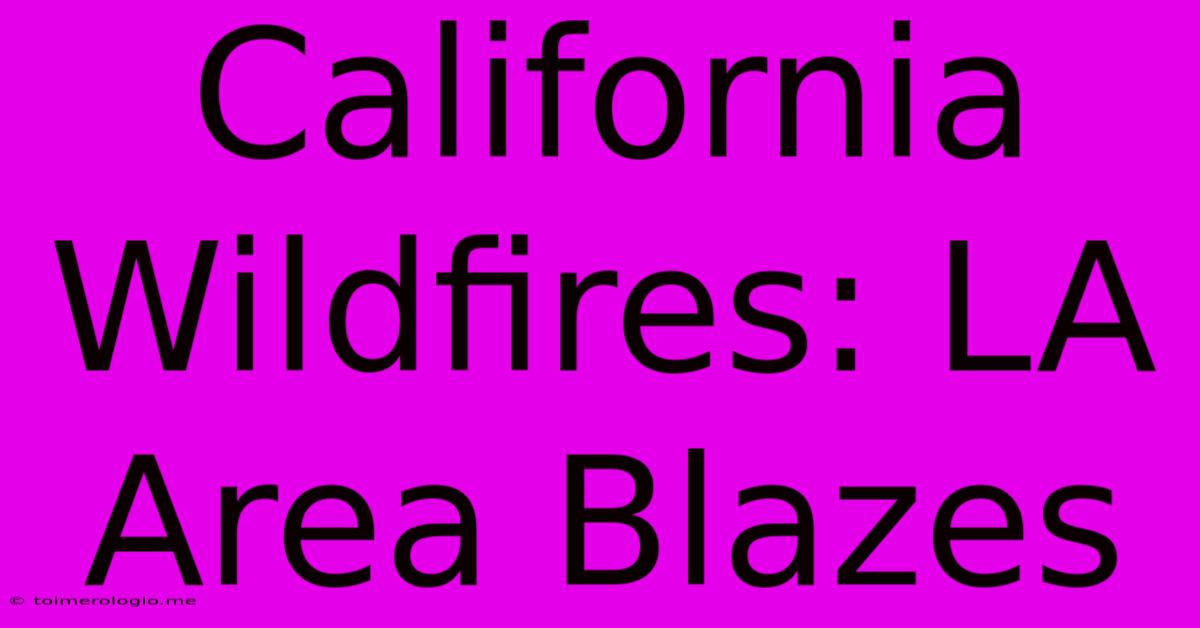California Wildfires: LA Area Blazes

Discover more detailed and exciting information on our website. Click the link below to start your adventure: Visit Best Website toimerologio.me. Don't miss out!
Table of Contents
California Wildfires: LA Area Blazes – A Devastating Reality
California wildfires are a recurring and increasingly severe threat, casting a long shadow over the lives and landscapes of the Golden State. While the entire state is vulnerable, the Los Angeles area, with its unique blend of sprawling urban development and chaparral wilderness, faces a particularly acute risk. This article delves into the devastating reality of LA area wildfires, examining their causes, impacts, and the ongoing efforts to mitigate their destructive power.
Understanding the LA Wildfire Threat
The LA area's vulnerability stems from a complex interplay of factors. The region's Mediterranean climate, characterized by hot, dry summers and mild, wet winters, creates ideal conditions for the growth of highly flammable vegetation like chaparral. These shrubs, adapted to infrequent but intense wildfires, accumulate dry fuel throughout the year, becoming tinderboxes waiting for a spark.
Fueling the Flames: Key Factors
- Climate Change: Rising temperatures and prolonged droughts exacerbated by climate change significantly increase the risk and intensity of wildfires. Drier vegetation burns faster and hotter, leading to larger, more destructive blazes.
- Santa Ana Winds: These infamous, powerful winds originating from the desert regions can rapidly spread wildfires, making them incredibly difficult to contain. Their dry, hot gusts fan flames and create unpredictable fire behavior.
- Human Activity: Accidental and intentional ignitions, ranging from faulty electrical equipment and discarded cigarettes to arson, remain a significant cause of wildfires. Urban sprawl encroaching on wildland-urban interface (WUI) areas further increases the risk.
- Vegetation Management: Lack of proper forest management, including controlled burns and thinning of overgrown vegetation, contributes to the accumulation of fuel, making wildfires larger and more intense.
The Devastating Impacts: Loss and Recovery
The consequences of LA area wildfires are far-reaching and deeply impactful. The immediate effects are catastrophic:
Immediate Impacts:
- Property Loss: Homes, businesses, and infrastructure are often destroyed, leaving residents displaced and facing immense financial hardship. The emotional toll of losing cherished possessions and memories is immeasurable.
- Loss of Life: Wildfires tragically claim lives, both directly through flames and indirectly through smoke inhalation and related health issues.
- Environmental Damage: Wildfires devastate ecosystems, destroying habitats and leading to significant biodiversity loss. Soil erosion, water contamination, and air pollution are also significant environmental consequences.
- Economic Disruption: The economic fallout is substantial, impacting tourism, real estate, and local economies. The cost of firefighting, recovery, and rebuilding runs into billions of dollars.
Long-Term Consequences:
- Air Quality: Smoke from wildfires significantly degrades air quality, leading to respiratory problems and other health issues, affecting both residents and wildlife. The long-term impact on public health is a serious concern.
- Landslide Risk: Burn scars left by wildfires increase the risk of landslides, particularly during periods of heavy rainfall. This poses further threats to communities and infrastructure.
- Mental Health Impacts: The trauma of experiencing a wildfire, losing a home, or witnessing the destruction can have long-lasting mental health consequences for survivors.
- Water Supply: Wildfires can contaminate water sources, impacting drinking water supplies and posing health risks.
Fighting the Flames: Prevention and Response
Combating LA area wildfires requires a multi-pronged approach that integrates prevention, preparedness, and effective response strategies.
Prevention and Mitigation:
- Improved Forest Management: Implementing proactive forest management practices, including controlled burns and thinning, is crucial to reducing fuel loads and creating firebreaks.
- Building Codes and Regulations: Stricter building codes and regulations for homes in WUI areas are essential to reduce the risk of property loss. This includes using fire-resistant materials and implementing defensible space around homes.
- Public Education and Awareness: Raising public awareness about wildfire risks, preventative measures, and emergency preparedness is essential.
- Early Warning Systems: Investing in advanced early warning systems to provide timely alerts to residents and emergency responders is critical.
Response and Recovery:
- Improved Firefighting Resources: Investing in advanced firefighting technology, equipment, and personnel is crucial for effective wildfire suppression.
- Community Preparedness: Developing comprehensive community wildfire preparedness plans and emergency evacuation procedures is essential.
- Post-Fire Recovery and Rebuilding: Providing resources and support to communities affected by wildfires to assist with rebuilding and recovery efforts is vital.
- Climate Change Mitigation: Addressing climate change through reducing greenhouse gas emissions is critical to mitigating the long-term risk of wildfires.
The Future of Fire in LA: A Call to Action
The future of wildfires in the LA area hinges on our ability to effectively address the underlying causes and implement comprehensive mitigation strategies. Climate change presents a significant challenge, demanding global action to reduce greenhouse gas emissions. However, local efforts are equally crucial.
Stronger collaboration between government agencies, local communities, and researchers is essential to develop and implement effective wildfire prevention, preparedness, and response strategies. This includes improved forest management, stricter building codes, enhanced early warning systems, and community-based resilience initiatives. The ongoing battle against LA area wildfires demands a long-term commitment to proactive measures, community engagement, and a deep understanding of the complex interplay of factors fueling these devastating blazes. The future safety and well-being of the region depend on it.

Thank you for visiting our website wich cover about California Wildfires: LA Area Blazes. We hope the information provided has been useful to you. Feel free to contact us if you have any questions or need further assistance. See you next time and dont miss to bookmark.
Also read the following articles
| Article Title | Date |
|---|---|
| Premier League Escapes 2023 24 Psr Fees | Jan 15, 2025 |
| High Winds Spread Southern California Fire | Jan 15, 2025 |
| Santa Ana Winds Drive Ventura County Fire | Jan 15, 2025 |
| 2 2 Draw Brentford Battles City | Jan 15, 2025 |
| Nottingham Forest Vs Liverpool Live Updates | Jan 15, 2025 |
